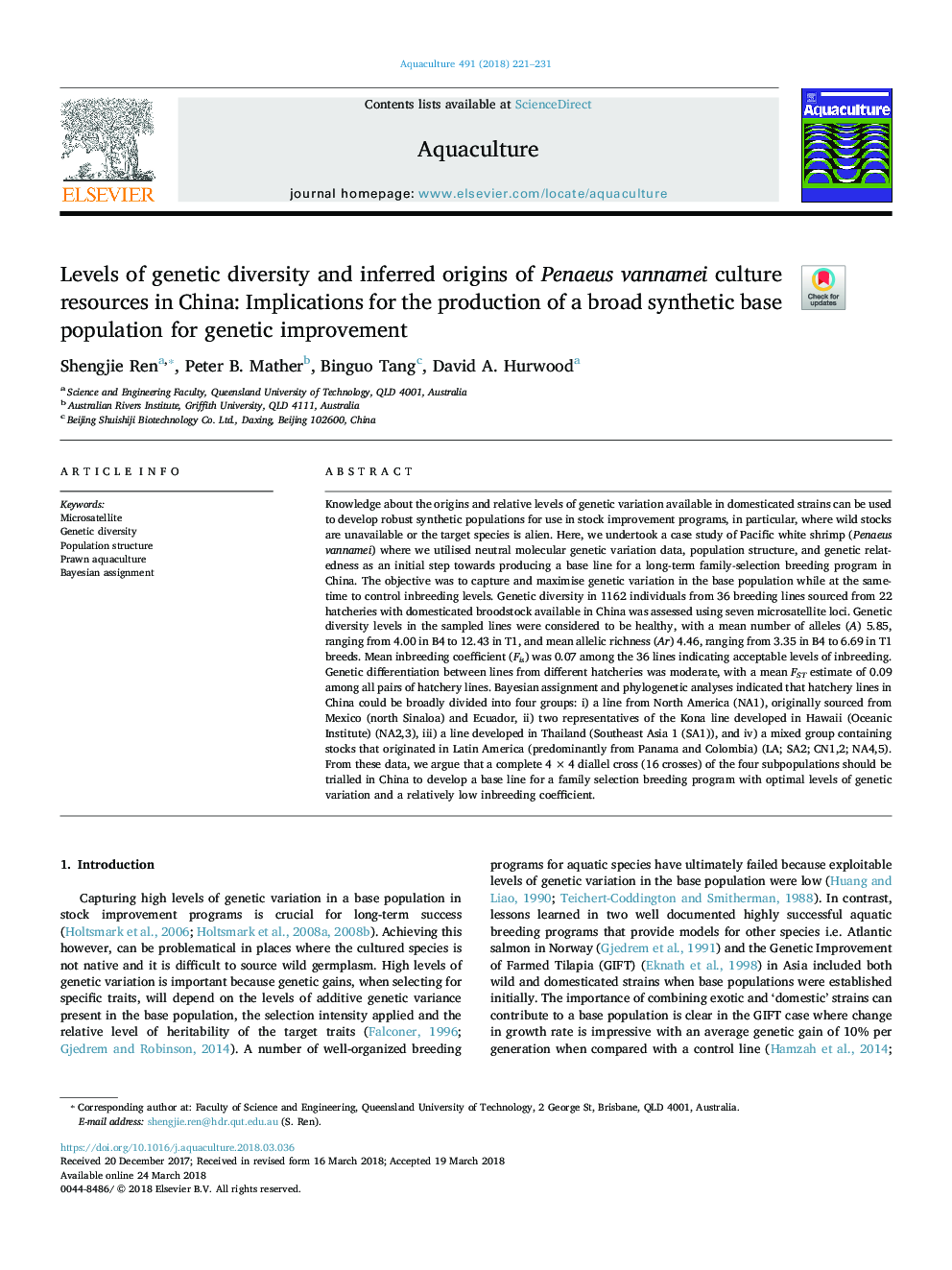| کد مقاله | کد نشریه | سال انتشار | مقاله انگلیسی | نسخه تمام متن |
|---|---|---|---|---|
| 8493231 | 1552797 | 2018 | 11 صفحه PDF | دانلود رایگان |
عنوان انگلیسی مقاله ISI
Levels of genetic diversity and inferred origins of Penaeus vannamei culture resources in China: Implications for the production of a broad synthetic base population for genetic improvement
دانلود مقاله + سفارش ترجمه
دانلود مقاله ISI انگلیسی
رایگان برای ایرانیان
کلمات کلیدی
موضوعات مرتبط
علوم زیستی و بیوفناوری
علوم کشاورزی و بیولوژیک
علوم آبزیان
پیش نمایش صفحه اول مقاله

چکیده انگلیسی
Knowledge about the origins and relative levels of genetic variation available in domesticated strains can be used to develop robust synthetic populations for use in stock improvement programs, in particular, where wild stocks are unavailable or the target species is alien. Here, we undertook a case study of Pacific white shrimp (Penaeus vannamei) where we utilised neutral molecular genetic variation data, population structure, and genetic relatedness as an initial step towards producing a base line for a long-term family-selection breeding program in China. The objective was to capture and maximise genetic variation in the base population while at the same-time to control inbreeding levels. Genetic diversity in 1162 individuals from 36 breeding lines sourced from 22 hatcheries with domesticated broodstock available in China was assessed using seven microsatellite loci. Genetic diversity levels in the sampled lines were considered to be healthy, with a mean number of alleles (A) 5.85, ranging from 4.00 in B4 to 12.43 in T1, and mean allelic richness (Ar) 4.46, ranging from 3.35 in B4 to 6.69 in T1 breeds. Mean inbreeding coefficient (Fis) was 0.07 among the 36 lines indicating acceptable levels of inbreeding. Genetic differentiation between lines from different hatcheries was moderate, with a mean FST estimate of 0.09 among all pairs of hatchery lines. Bayesian assignment and phylogenetic analyses indicated that hatchery lines in China could be broadly divided into four groups: i) a line from North America (NA1), originally sourced from Mexico (north Sinaloa) and Ecuador, ii) two representatives of the Kona line developed in Hawaii (Oceanic Institute) (NA2,3), iii) a line developed in Thailand (Southeast Asia 1 (SA1)), and iv) a mixed group containing stocks that originated in Latin America (predominantly from Panama and Colombia) (LA; SA2; CN1,2; NA4,5). From these data, we argue that a complete 4â¯Ãâ¯4 diallel cross (16 crosses) of the four subpopulations should be trialled in China to develop a base line for a family selection breeding program with optimal levels of genetic variation and a relatively low inbreeding coefficient.
ناشر
Database: Elsevier - ScienceDirect (ساینس دایرکت)
Journal: Aquaculture - Volume 491, 1 April 2018, Pages 221-231
Journal: Aquaculture - Volume 491, 1 April 2018, Pages 221-231
نویسندگان
Shengjie Ren, Peter B. Mather, Binguo Tang, David A. Hurwood,